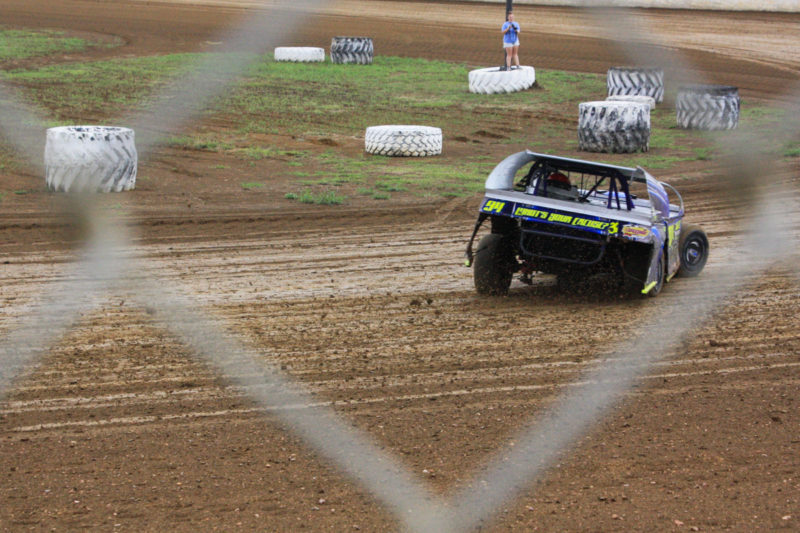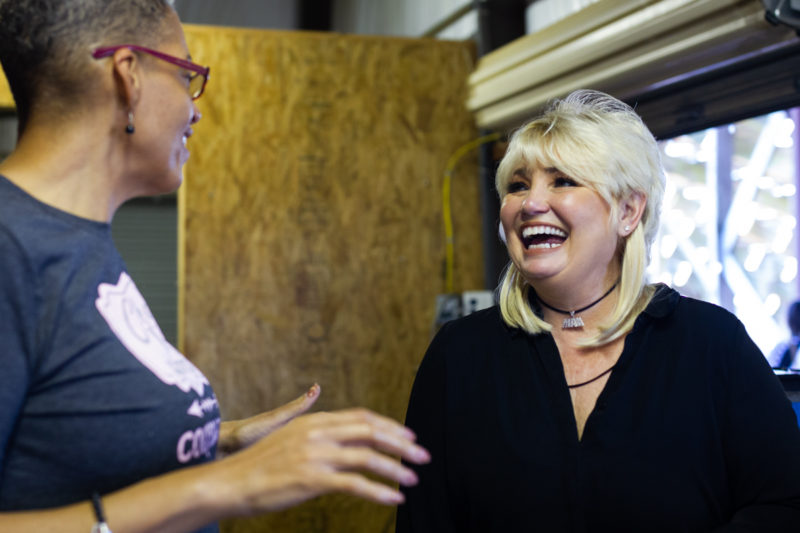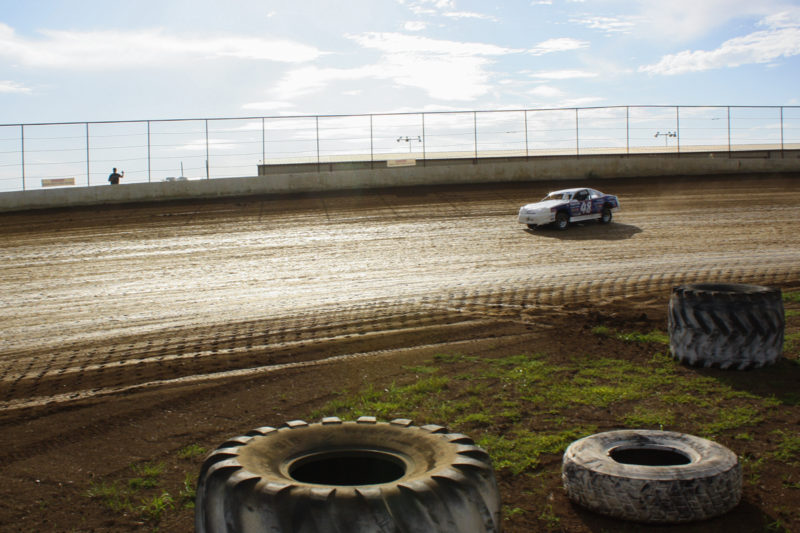With Stock Car Racing on the Decline in Texas, One Woman Seeks to Save a Dying Track
By Kate Groetzinger
Reporting Texas

Chris Morris drives a car around the track at the Cotton Bowl Speedway in preparation for the final race of the season on Oct. 7, 2018. Kate Groetzinger/Reporting Texas.
On a damp Saturday in October, Mary Ann Naumann, 64, peered through a chain-link fence encircling the racetrack at the Cotton Bowl Speedway near the tiny Central Texas community of Paige. Stock cars whizzed around the three-eighths-mile track. Thirty minutes earlier, Naumann, wearing a full face of makeup and white jeans, had been driving around the oval track in a pickup truck, packing down the track’s red dirt.
For her day job, Naumann helps oversee Formula One races at Austin’s Circuit of The Americas racetrack, but her real passion is short track racing, which occurs on dirt tracks scattered in rural Texas. In 2003, Naumann created MAN Racing Promotions, a short track promotion company.
In Texas, there are about 30 dirt short tracks in operation. The last asphalt short track in the state shut down in 2016, and at least eight dirt tracks in the state have been decommissioned in the past decade. So when Naumann heard that a short track near Austin was closing at the end of 2017, she and her husband stepped in to run it.
“We really jumped in to try to save the remaining part of local racing,” she said. “If they closed the track there would be no more racing around here.
Stock car racing began in the U.S. during the prohibition era when alcohol bootleggers modified commercially available cars to outrun law enforcement. Eventually they began racing those cars for pleasure. NASCAR was formed in the 1940s to regulate the races, and the sport gained traction throughout the 20th century before losing popularity in the 2000s.
Naumann grew up going to stock car races with her family at Austin Speed-O-Rama, an asphalt short track in southeast Austin where her father raced and she served as the trophy girl. The track closed around 1999.
“Dad raced on Friday night, and we got together on Saturday morning and made changes to the car, then went to another track in San Antonio or somewhere else on Saturday night,” Naumann said.
Forty-seven-year-old Austin resident Rodney Rodriguez remembers cheering for Naumann’s father, Jake Wallace, at the Speed-O-Rama track in the 1970s.
“The first race car that I ever sat in as a kid was her dad’s,” Rodriguez said. “He was just a gentleman. He raced clean and did the right stuff.”
Rodriguez raced with Naumann’s brother, Jake Wallace Jr., in the 1990s, and became good friends with the Wallace family. When Naumann started racing in 1996, Rodriguez competed against her at Austin Speed-O-Rama, which had been renamed Longhorn Speedway.
“She was one of the only ladies out there,” Rodriguez said, “She was good. She put it on us.”
Naumann went on to make a name for herself in the 2000s as a race promoter. She started the Texas Super Racing Series in 2003. The series solved one of the big problems in asphalt short track racing, which was that tracks throughout the state had inconsistent rules.

Mary Ann Naumann and a co-worker set up food stations for the Lantern Festival hosted at the Cotton Bowl Speedway on Oct. 27, 2018. Bonny Chu/Reporting Texas.
Naumann developed her own set of rules and recruited a group of drivers to race against each other at several asphalt tracks around the state. The series eventually brought her national recognition.
“It was very successful in the racing magazines,” Naumann said. “Because I was a woman promoter in a male-dominated field.”
Naumann brought the same energy to races at Thunderhill, an asphalt short track in Kyle that opened in 1998. She became the general manager at the track in 2003 and then a partner in 2007. She hired Rodriguez as a race announcer in 2008.
“When Mary Ann came on board, she took it to another level,” Rodriguez said. “It became a lot more fan friendly. That’s something you’ll see anywhere Mary Ann is. She will do stuff to get kids involved, and any track she runs will have the cleanest bathrooms.”
Naumann made the drivers take kids on rides in their cars on race night. She created a “victory lane” where fans could meet their favorite drivers and get autographs. Before races she introduced each driver, giving them nicknames that the crowd could remember.
Around 2008, asphalt short tracks started closing in Texas, leading to the end of the Texas Super Racing Series. In 2012, Naumann was forced to leave Thunderhill when the owner raised the rent. Circuit of the Americas opened the same year, offering her a way to continue her career.
In 2016, drivers who had raced at Thunderhill, started racing at the Cotton Bowl Speedway in Paige. Naumann and her husband, H, got in the habit of spending Friday nights at the track.
“My husband was determined he wasn’t going to like dirt,” Naumann said. “It’s so different from the asphalt world. But if there are race cars on the track, then I want to see it.”
Just as she was starting to like dirt racing, she heard the track might be closing. The owner had decided to put it up for sale after going through a divorce.
“The drivers started calling me, saying, ‘Please, please, please, Mary Ann, save Cotton Bowl,’” Naumann said. She and her husband decided to lease the track for a year and see if they could make it work.
Unlike asphalt tracks, dirt tracks are completely at the mercy of the weather. When it’s dry and sunny, the track needs to be sprayed with water to keep the dust down. When it rains, the track becomes a giant pit of mud.
“In the beginning, we took two steps and fell back five,” Naumann said. “We had the guts of it, but we had no earthly idea the amount of work it took to keep up the actual dirt race track.”
Her husband did most of the manual labor at the track, grooming the dirt each week with help from drivers, while Naumann worked on bringing new drivers and fans to the races.
“You kind of forget what worked in the past,” she said. “I was always about music when the cars pull on the track, I was always about good announcing, about people knowing who’s in the cars. And the kids have always been huge. If you don’t have the kids involved the sport will go away.”

Duane Toyne practices at the Cotton Bowl Speedway ahead of the final race of the season on Oct. 7, 2018. Kate Groetzinger/Reporting Texas.
Naumann said the drivers at the Cotton Bowl Speedway are older than the drivers were at the tracks she went to as a kid.
“In my world, a lot of the kids were involved, and there’s your next generation. That next generation didn’t happen. I find now that it’s an aged group of people,” she said.
While it may spell doom for the sport as a whole, the older clientele worked in Naumann’s favor. Her reputation brought veteran drivers to the track, and a tight-knit community took shape.
“The atmosphere seemed to be like the old Longhorn days,” she said, referring to the track where she and her family raced in the 1990s.
But a series of rainouts sent the Cotton Bowl Speedway’s finances into the red during the 2018 season. The problem grew worse as the season progressed.
“By the time we got into a rhythm, we were struggling financially to keep things going,” Naumann said. “The rain just hurt us so much.”
Naumann never expected to make any money off the track. She got into it for the drivers and for her granddaughter, Taylor Stewart, who is now the trophy girl at the Cotton Bowl Speedway, just like Naumann was at Longhorn Speedway. But mostly, she did it for herself.
“I don’t think I will ever retire,” she said. “I don’t like to travel. I don’t like the ocean. I like racing. I just want to gamble and race.”
And running a dirt racetrack is a lot like gambling. You never know when rain will ruin your season, as it did for Naumann in 2018. But she’s not giving up. Naumann plans to rent the track for one more year, if she can get a break on the rent, and possibly another year after that.
“It’s kind of like being at the slot machine and you’ve got that 100 dollars left,” she said, “You can walk away and say ‘I had a good time’ or pull the lever and hope you hit the jackpot.”